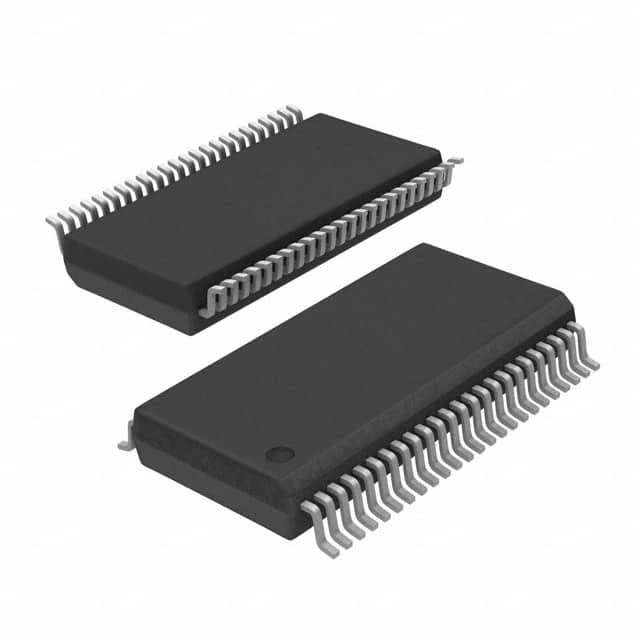Viz Specifikace pro podrobnosti o produktu.

Encyclopedia Entry: 74FCT162H245ATPAG8
Product Overview
Category
The 74FCT162H245ATPAG8 belongs to the category of integrated circuits (ICs) and specifically falls under the family of bus transceivers.
Use
This product is primarily used for bidirectional data communication between two buses with different voltage levels. It enables the transfer of digital signals between these buses, ensuring compatibility and efficient data transmission.
Characteristics
- Bidirectional data transfer
- Voltage level translation
- High-speed operation
- Low power consumption
- Robust design for reliable performance
Package
The 74FCT162H245ATPAG8 is available in a surface mount package. The specific package type is TSSOP (Thin Shrink Small Outline Package), which provides compactness and ease of integration into electronic systems.
Essence
The essence of this product lies in its ability to facilitate seamless data transfer between buses operating at different voltage levels, ensuring smooth communication within a system.
Packaging/Quantity
The 74FCT162H245ATPAG8 is typically packaged in reels or tubes, containing a specified quantity of ICs per package. The exact packaging and quantity may vary depending on the manufacturer's specifications.
Specifications
- Supply Voltage Range: 2.0V to 5.5V
- Operating Temperature Range: -40°C to +85°C
- Data Rate: Up to 200 Mbps
- Number of Channels: 16
- Input/Output Compatibility: TTL/CMOS
Detailed Pin Configuration
The 74FCT162H245ATPAG8 has a total of 48 pins, each serving a specific function. Here is a detailed pin configuration:
- A1
- B1
- GND
- B2
- A2
- VCC
- A3
- B3
- GND
- B4
- A4
- OE#
- DIR
- GND
- B5
- A5
- VCC
- A6
- B6
- GND
- B7
- A7
- A8
- B8
- GND
- B9
- A9
- VCC
- A10
- B10
- GND
- B11
- A11
- OE#
- DIR
- GND
- B12
- A12
- VCC
- A13
- B13
- GND
- B14
- A14
- A15
- B15
- GND
- B16
Functional Features
- Bidirectional data transfer between two buses with different voltage levels.
- Automatic direction control based on the DIR pin.
- Output enable (OE#) pin for enabling/disabling the output buffers.
- TTL/CMOS compatible inputs and outputs.
- High-speed operation allows for efficient data transmission.
Advantages and Disadvantages
Advantages
- Enables seamless communication between buses with different voltage levels.
- Supports high-speed data transfer.
- Low power consumption for energy-efficient operation.
- Robust design ensures reliable performance in various applications.
Disadvantages
- Limited to 16 channels, which may not be sufficient for certain complex systems.
- Requires careful consideration of voltage compatibility to avoid potential damage.
Working Principles
The 74FCT162H245ATPAG8 operates by utilizing a bidirectional transceiver architecture. It employs voltage level translation techniques to enable data transfer between buses operating at different voltage levels. The DIR pin controls the direction of data flow, while the OE# pin enables or disables the output buffers.
Detailed Application Field Plans
The 74FCT162H245ATPAG8 finds applications in various fields where bidirectional data communication between buses with different voltage levels is required. Some specific application areas include:
- Industrial automation systems
- Automotive electronics
- Communication equipment
- Consumer electronics
- Medical devices
Detailed and Complete Alternative Models
- SN74LV245A: This bus transceiver offers similar functionality and characteristics.
- MC74VHC245: Another alternative that provides bidirectional voltage level translation capabilities.
- CD74HCT245: A compatible IC suitable for bidirectional data transfer between buses with different voltage levels.
These alternative models offer comparable features and can be considered as substitutes for the 74FCT162H245ATPAG8 based on specific requirements.
Word count: 565 words
Seznam 10 běžných otázek a odpovědí souvisejících s aplikací 74FCT162H245ATPAG8 v technických řešeních
Sure! Here are 10 common questions and answers related to the application of 74FCT162H245ATPAG8 in technical solutions:
Q: What is the function of the 74FCT162H245ATPAG8? A: The 74FCT162H245ATPAG8 is an octal bus transceiver with 3-state outputs. It can be used to enable bidirectional transfer of data between two buses.
Q: What is the voltage range supported by the 74FCT162H245ATPAG8? A: The 74FCT162H245ATPAG8 supports a voltage range of 4.5V to 5.5V.
Q: How many channels does the 74FCT162H245ATPAG8 have? A: The 74FCT162H245ATPAG8 has 8 channels, allowing for simultaneous bidirectional data transfer on each channel.
Q: Can the 74FCT162H245ATPAG8 handle high-speed data transfer? A: Yes, the 74FCT162H245ATPAG8 is designed to support high-speed data transfer up to 250MHz.
Q: Does the 74FCT162H245ATPAG8 have built-in protection features? A: Yes, the 74FCT162H245ATPAG8 has built-in ESD protection to safeguard against electrostatic discharge.
Q: Can the 74FCT162H245ATPAG8 be used in both parallel and serial communication systems? A: Yes, the 74FCT162H245ATPAG8 can be used in both parallel and serial communication systems, depending on the configuration.
Q: What is the power supply requirement for the 74FCT162H245ATPAG8? A: The 74FCT162H245ATPAG8 requires a single power supply of 5V.
Q: Does the 74FCT162H245ATPAG8 support hot insertion and removal of devices? A: Yes, the 74FCT162H245ATPAG8 supports hot insertion and removal of devices without causing damage to the transceiver.
Q: Can the 74FCT162H245ATPAG8 be used in automotive applications? A: Yes, the 74FCT162H245ATPAG8 is suitable for automotive applications as it meets the necessary industry standards.
Q: Are there any specific layout considerations when using the 74FCT162H245ATPAG8? A: Yes, it is recommended to follow the layout guidelines provided in the datasheet to ensure proper signal integrity and minimize noise interference.
Please note that these answers are general and may vary depending on the specific application and requirements. It is always advisable to refer to the datasheet and consult with the manufacturer for detailed information.

